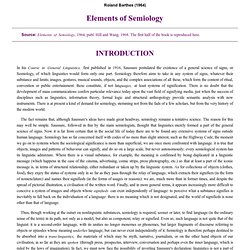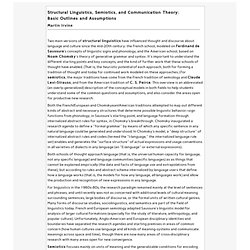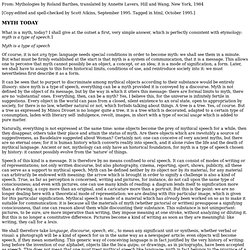

Semiotics and Cultural Criticism by Arthur Berger. Arthur Asa BergerCultural Criticism: Semiotics and Cultural Criticism In this chapter I address some of the basic concepts in semiotics, to show how it enables us to find meaning in texts and other phenomena.

I try to explain each concept as simply as possible, and I quote extensively from important passages written by various authorities, to give the reader some idea of how these writers express themselves. There is, however, a certain amount of technical language involved with semiotic analysis that cannot be avoided. There are many advanced books on semiotics available or those who wish to pursue the study of semiotic theory and applied semiotic analysis; interested readers will find several such titles in the list of suggested further reading that follows the final chapter in this volume. Semiotics can be seen as a form of applied linguistics; semiotic malysis has been applied to everything from fashion to advertis- ing, from James Bond stories to Star Wars.
How Signs Function Codes. Tractatus Logico-Philosophicus. What Is Semiotics & Cultural Theory? Gregory Bateson: lectura en clave semiótica de una aventura epistemológica del siglo XX. Gregory Bateson: lectura en clave semiótica de una aventura epistemológica del siglo XX María José Lucerga Pérez (Universidad de Murcia) Me reencuentro con Gregory Bateson después de ocho años y, como si no hubiera pasado el tiempo, vuelvo a sentirme cautivada por su pensamiento original y heterodoxo y su estilo desenvuelto y elegante.

Pero el tiempo sí ha transcurrido. En las últimas décadas hemos asistido al interesado fin de la Historia, a la renuncia postmoderna a los modelos globales sin que ello signifique necesariamente una defensa de lo complejo, al creciente divorcio entre humanidad y naturaleza traducido en el expolio de los recursos del planeta y en la cosificación de sus habitantes, al desciframiento del mapa del genoma humano y al intento de convertirlo en mercancía, a la revolución de Internet y a la consagración de un paradigma comunicativo asumido sólo en sus aspectos más técnicos. Formalist, Structuralist, and Semiotic Analyses of Culture.
Elements of Semiology by Roland Barthes. Roland Barthes (1964) Source: Elements of Semiology, 1964, publ.

Hill and Wang, 1968. The first half of the book is reproduced here. Images Analyses : pédagogie et éducation à l'image. Semiotics and Communication. Structural Linguistics, Semiotics, and Communication Theory: Basic Outlines and Assumptions Martin Irvine Two main versions of structural linguistics have influenced thought and discourse about language and culture since the mid-20th century: the French school, modeled on Ferdinand de Saussure’s concepts of linguistic signs and phonology, and the American school, based on Noam Chomsky's theory of generative grammar and syntax.

It's important to understand the different starting points and key concepts, and the kind of further work that these schools of thought have enabled. (That is, the heuristic potential of each approach, both for forming a tradition of thought and today for continued work modeled on these approaches.) For semiotics, the major traditions have come from the French tradition of semiology and Claude Levi-Strauss, and from the American tradition of C. What are the Structures in Structuralism? Practical Semiotics - Master the Hidden Depths of your Brand. Semiotics for Beginners by Daniel Chandler.
Barthes-Myth. From: Mythologies by Roland Barthes, translated by Annette Lavers, Hill and Wang, New York, 1984 [Copy-edited and spell-checked by Scott Atkins, September 1995.

Tagged in html, October 1995.] What is a myth, today? I shall give at the outset a first, very simple answer, which is perfectly consistent with etymology: myth is a type of speech.1 Myth is a type of speech Of course, it is not any type: language needs special conditions in order to become myth: we shall see them in a minute. It can be seen that to purport to discriminate among mythical objects according to their substance would be entirely illusory: since myth is a type of speech, everything can be a myth provided it is conveyed by a discourse.
Naturally, everything is not expressed at the same time: some objects become the prey of mythical speech for a while, then they disappear, others take their place and attain the status of myth. Speech of this kind is a message. Myth as a semiological system Language 1.Signifier 2.Signified. Semiotics and Communication. ¦ Material Culture, Design and Semiotics ¦ Media and Semiotic Theory: Key Terms and Concepts. Libreros: Roland Barthes - Retorica de la imagen. Según una etimología antigua, la palabra imagen debería relacionarse con la raíz de imitari.

Henos aquí de inmediato frente al problema más grave que pueda plantearse a la semiología de las imágenes: ¿puede acaso la representación analógica (la) producir verdaderos sistemas de signos y no sólo simples aglutinaciones de símbolos? ¿Puede concebirse un analógico, y no meramente digital? Sabemos que los lingüísticos consideran ajena al lenguaje toda comunicación por analogía, desde el de las abejas hasta el por gestos, puestos que esas comunicaciones no poseen una doble articulación, es decir, que no se basan como los fonemas, en una combinación de unidades digitales. Los lingüistas no son los únicos en poner en duda la naturaleza lingüista de la imagen. Ahora bien, aún cuando la imagen sea hasta cierto punto límite de sentido (y sobre todo por ello), ella nos permite volver a una verdadera ontología de la significación. Los tres mensajes El mensaje lingüístico.